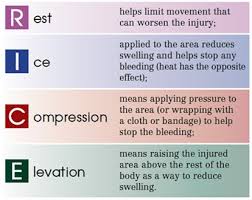RICE for Sprains and Strains
We have all been there. You see your child learning something you never thought possible. It is a dream come true. Then, in the blink of an eye, she is on the floor. It is not in a good way. Is it a major injury? Is it a minor boo boo? Why is the doctor’s office never open during cheer hours?
While the remedy for sprains and other muscle and joint injuries vary, the immediate treatment remains the same.
For a sprain or strain – use RICE
RICE. While it is a food grain, it is also an acronym most commonly associated with treatments for sprains and strains. Most Doctors will attest that the best way to handle slight strains and sprains is through a series of four steps, rest, ice, compress, and elevate. RICE has become an acronym widely used in competitive sports to treat those minor aches and pains that occur after hours. Let face it, MOST of our kid’s injuries seem to happen after hours. While I do not advise doing this in place of seeking treatment, it is something that can be done until a doctor’s appointment can be made.
REST – Sounds simple doesn’t it? You try it. Rest your right hand for 3 hours. Nor so simple is it? Yet rest is the most important element to recovery. With any ache and pain in an isolated area, be sure to have your child rest the limb as much as possible. This may mean crutches or braces to help remind the child not to use that arm or leg that is hurt. Kids in school may need a note to excuse them from the gym, use the school elevator, or take extra time to get to class.
ICE – Cold compresses reduce swelling. It is the swelling that produces the most pain and discomfort. Ice an injury for 20 minutes and then rest for 20. Repeat several times – 20 on, 20 off, 20 on. Recovery times have been shown to increase dramatically just by using this method – even without the assistance of medication. Easy method – have them watch a one hour program. First segment until the commercial, ice, next segment, off. Keep alternating until the show is over.
COMPRESS – Wrap the injured area if possible. It is key to wrap the area correctly. I will not go into details, as each body part has its own way of wrapping, but the instructions can easily be found online by googling “leg sprain wrap” or “how to wrap a strained wrist”. Be sure circulation is not cut off. If you see the area below the wrap start to turn color like blue or white, or if the area becomes numb, unwrap immediately and allow the blood to flow back into the extremity before wrapping in a looser fashion.
ELEVATE – This does not mean a one pillow raise. This means placing the sprained area above heart level. Laying down is the easiest way to accomplish this. With an arm or hand it is best to place over the head, while with legs you may need to drape it over the side of the couch or armchair. You can do this in connection with the ice in a combined effort in treatment. School children may need a second note allowing them to place their feet on a chair. While it is not over their head, which most of us can agree would look silly in school, it is better than on the floor. It will also help alleviate the pain throughout the day, and reduce swelling when ice is not available. For those in need of prolonged elevation, considering options like the SonderCare collection in their hospital bed catalog can provide additional comfort and support.
It is never advisable to self-diagnose or treat an injury, as this may lead to longer healing times and risk complications. While it is always best to seek professional opinion for any injury – sometimes it is not always available immediately. In those cases, R.I.C.E can help reduce swelling and pain until the child can be seen by a physician for proper diagnosis. If the swelling does not go down, if discoloration or disfigurement is evident – please seek emergency medical attention immediately to rule out a more serious injury. Please remember that some schools and gyms require a doctor’s note for any accommodations. In those cases, be sure to get multiple notes that blanket covers all accommodations that may need to be made, including extra hall time, elevator use, using a chair to elevate a limb, no writing, assistance in the book or backpack carrying, and gym or practice restrictions. Most doctors charge extra is you need to return for an extra note, so be sure to have it all in place before you leave.
Resources
Google Images
http://www.heartofcheer.com/cheerleaders/rice-sprains-strains/http://www.heartofcheer.com/wp-content/uploads/2014/12/rice2.gifhttp://www.heartofcheer.com/wp-content/uploads/2014/12/rice2-150x150.gifBlogCheerleadersCoachesHealthParentsfirst aid,RICE,sprains



